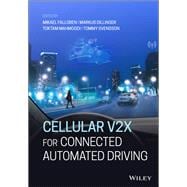A unique examination of cellular communication technologies for connected automated driving, combining expert insights from telecom and automotive industries as well as technical and scientific knowledge from industry and academia
Cellular vehicle-to-everything (C-V2X) technologies enable vehicles to communicate both with the network, with each other, and with other road users using reliable, responsive, secure, and high-capacity communication links. Cellular V2X for Connected Automated Driving provides an up-to-date view of the role of C-V2X technologies in connected automated driving (CAD) and connected road user (CRU) services, such as advanced driving support, improved road safety, infotainment, over-the-air software updates, remote driving, and traffic efficiency services enabling the future large-scale transition to self-driving vehicles. This timely book discusses where C-V2X technology is situated within the increasingly interconnected ecosystems of the mobile communications and automotive industries.
An expert contributor team from both industry and academia explore potential applications, business models, standardization, spectrum and channel modelling, network enhancements, security and privacy, and more. Broadly divided into two parts—introductory and advanced material—the text first introduces C-V2X technology and introduces a variety of use cases and opportunities, requiring no prerequisite technical knowledge. The second part of the book assumes a basic understanding of the field of telecommunications, presenting technical descriptions of the radio, system aspects, and network design for the previously discussed applications. This up-to-date resource:
- Provides technical details from the finding of the European Commission H2020 5G PPP 5GCAR project, a collaborative research initiative between the telecommunications and automotive industries and academic researchers
- Elaborates on use cases, business models, and a technology roadmap for those seeking to shape a start-up in the area of automated and autonomous driving
- Provides up to date descriptions of standard specifications, standardization and industry organizations and important regulatory aspects for connected vehicles
- Provides technical insights and solutions for the air interface, network architecture, positioning and security to support vehicles at different automation levels
- Includes detailed tables, plots, and equations to clarify concepts, accompanied by online tutorial slides for use in teaching and seminars
Thanks to its mix of introductory content and technical information, Cellular V2X for Connected Automated Driving is a must-have for industry and academic researchers, telecom and automotive industry practitioners, leaders, policymakers, and regulators, and university-level instructors and students.
Additional resources available at the following site: Cellular V2X for Connected Automated Driving – 5GCAR









